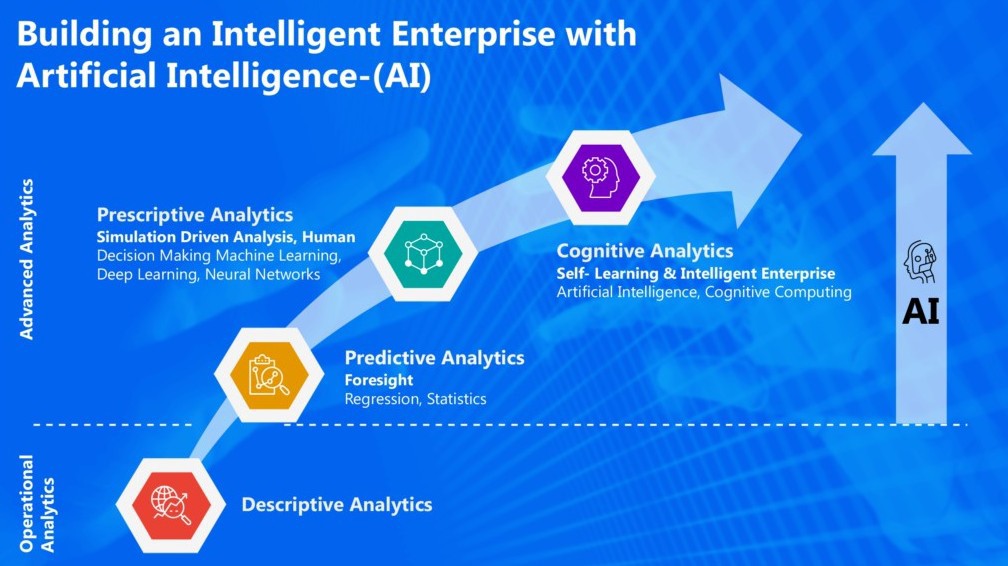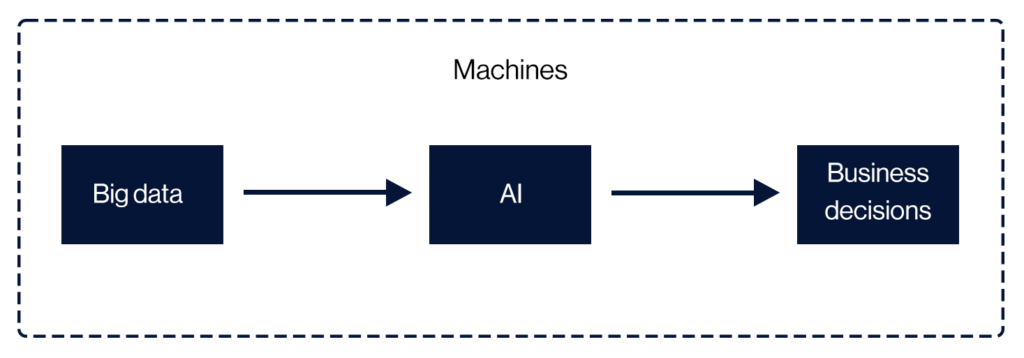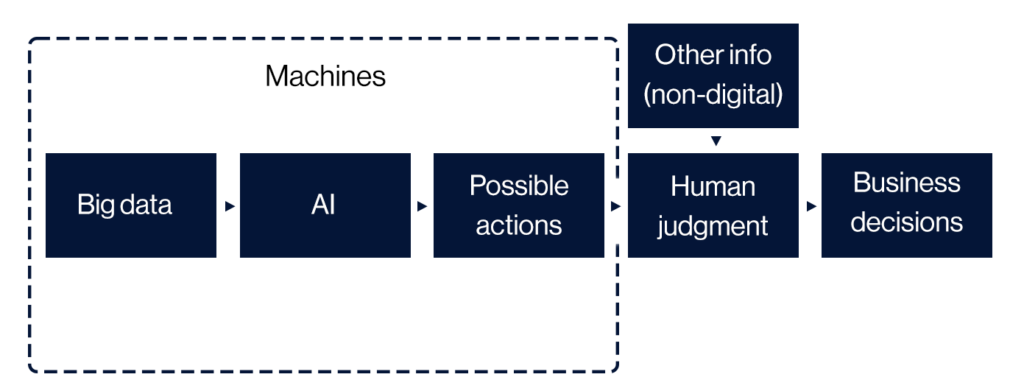
Data is the backbone of a modern business – it helps us make better decisions and learn more about our customers. But with all this data comes a problem: how can our brains possibly process it all?
That’s where artificial intelligence (AI) decision making comes into play. AI decision making is where companies utilize AI in their processes to help make faster, more accurate, more consistent decisions by leveraging datasets with AI. Unlike humans, AI can analyze large datasets in seconds without errors, freeing up your team to focus on other work.
What is AI Decision Making?
AI decision making is when data processing – like analyzing trends and suggesting courses of action – is done either in part or completely by an AI platform instead of a human to quantify data in order to make more accurate predictions and decisions.
In theory, by handing over your data to an AI platform, tasks like data crunching, trend spotting, anomaly detection and complex analysis can be done by AI. The final decision is then made by a person or automated entirely.
A Decision Making Model That Utilizes AI

Making decisions this way simplifies the process drastically, but it cuts out humans completely (which isn’t always a great idea). This is why processes that combine humans and AI are now gaining momentum. So, to say that AI decision making could be revolutionary for businesses is an understatement.
McKinsey predicts that by 2030, around 70% of businesses will be using at least one type of AI technology, and roughly half of all large companies will have a full range of AI tech embedded in their processes. AI decision making has the power to increase the world’s economic output, and the estimates are huge: a possible boost of around $13 trillion to the world economy by 2030, which is an extra 1.2% of global GDP for those playing along at home.
For businesses, adding AI to workflows is expected to be more important than increased profits and revenues. Gartner says businesses are now being digitally disrupted by the sheer amount of data they have to deal with – and it could overwhelm them. But with the help of AI, it’s possible to turn all that data into tangible outcomes, from sales and marketing through to demand planning and supply chains.
The size, complexity, distributed nature of data, speed of action and the continuous intelligence required by digital business means that rigid and centralized architectures and tools break down. The continued survival of any business will depend upon an agile, data-centric architecture that responds to the constant rate of change.
How Does AI Help in Decision Making?
AI is helpful for businesses because it has the unique ability to constantly teach itself – the more data-driven decisions it makes, the more it learns. AI trains itself and uses data collections to build models that become really, really good at making predictions and categorizations over this data. These same models can then be used on live data in real time to make predictions, categorizations and recommendations in real-time.
This is remarkably different from how businesses have operated over the last 100, 50, or even 20 years ago. Because up until now, there was a central point where every important decision was made: a human. Instead of relying on machines, humans analyzed data to decide everything. The issue with leaving every decision to a human is that we are all humans! Our emotions creep in, we get stressed, and our cognitive biases guide our decisions as much as the datasets do. These cognitive biases are simply bad for business. These biases are most problematic because they cause business people to make bad decisions. Only by filtering out the cognitive biases that are sure to arise while decisions are being made can you be confident that, at the end of the day, the best decision for you and your company was made based on the best available information.
Benefits of AI Decision Making
On paper, introducing AI into a business’ decision making process has the following benefits:
- AI helps businesses make better decisions: Quickly analyzing large datasets allows businesses to make instant decisions, which is can be incredibly time-consuming process for humans, but for a machine, it’s instant
- It can boost sales and marketing campaigns: AI applications like Natural Language Processing help companies understand how their customers are interacting with their brand, what words they’re using and what tone they should strike to make them more appealing
- It helps businesses understand their customers better: AI tools like chatbots, algorithms and machine learning provide companies with a deeper understanding of their customers’ pain points, expectations and satisfaction levels
- It allows companies to make decisions that take into account huge amounts of complex data: AI is uniquely positioned to help make sense of vast quantities of data, particularly where a clearly defined outcome is measurable. For AI, decisions can look at all of this data instantly – people can’t
The problem is that while decision makers tend to trust AI, getting their teams bought into the idea – and reassuring them that it isn’t here to take their jobs! – isn’t always easy. Studies suggest that this problem could stem from a lack of understanding and cultural differences about how helpful AI can be. 64% of decision makers say their team either doesn’t trust or understand AI-enabled decisions, making it hard for their organization to take full advantage of the technology.
It’s important to understand, though, that it doesn’t have to be this black and white. It’s not a case of deciding who is going to make every decision in a business, machines or humans – they both have their strengths and they both have their weaknesses.
AI is great at dealing with noise and complexity, looking at data sets and spotting trends instantly. But humans are fantastic at understanding certain external factors and making more creative-led decisions. In most cases, the best solution is for AI and humans to work together.
Can AI Make Smarter Decisions Than Humans?
Data – when it’s collected and analyzed correctly – can give decision makers deep, unparalleled insight into every part of a business. The problem modern companies face is that they’re drowning in data. Humans can’t keep up. And with so much data being collected, it’s not surprising that processes like spreadsheets and databases just don’t cut it anymore. So, businesses are left with a choice to make: do we keep humans in charge, or let the machines take over some of the data-driven decision making?
The reality is that humans are always going to be limited when it comes to making data-based decisions. Harvard Business Review says this is because:
- Humans don’t leverage all the data: We struggle to collate every aspect of a dataset, like insights, relationships and patterns. Humans tend to manage large amounts of data by summarizing it, and we physically can’t process millions (or billions) of records. Our minds simply struggle to link the relationships between data elements, which is key to good decision making
- Humans let our biases take over: We tend to prioritize data that we think is important, not what the data actually says. This is because humans tend to think of data as linear, and our brains can’t process aggregates like AI can. When a decision requires knowing the cities, ZIP codes and addresses of a thousand customers, humans may only be able to make a decision based on a regional level (e.g Northside of the city), whereas AI can easily aggregate the data needed and cut through the noise that may otherwise cloud a human’s judgment
And the reality is that AI doesn’t have feelings: it can make decisions and collate data without letting emotion, bias or human error get in the way. If so, is human involvment still needed in the decision making process?
Will AI Eliminate the Need for Human Decision Making?
Just because AI can collate data quicker than humans and analyze it more easily doesn’t mean that leaving everything up to machines is a smart business move. In reality, successful companies will always need that human touch. There are thousands of ways people can influence decision making for the better.
For example, imagine that you’re running a warehouse and your AI decision making process tells you that by cutting down on the amount of stock you keep, the company can save money on storage costs. On paper, this makes perfect sense. But to a team leader who knows that the extra stock allows the company to fulfill company orders without risking their supply chain – and keep customers happy with quick shipments – the extra storage costs are worth it. This type of decision making is different from the earlier example we looked at, where AI is in control. Here, human judgement overrides the decision made by AI.
A Decision Making Model that Combines the Power of AI and Human Judgment

And there’s still a place for this type of decision making in modern businesses.
Conclusions

Modern business owners are dealing with a lot of moving parts every day, from remote work to new technologies. The last thing business owners have time for is to spend hours (and hours) trying to analyze every row, column or cell of data to make decisions.
Thanks to AI decision making, business owners can now solve two problems at once. Mass datasets can be analyzed instantly, and cognitive biases can be removed from the process entirely so that every decision is made using cold, hard facts.
The only risk for business owners now is if they don’t take advantage of AI technology. More businesses are integrating AI into their tech stacks, making them more competitive with how targeted their marketing is, how accurately they can forecast future demand and how quickly they can pivot when problems arise.
